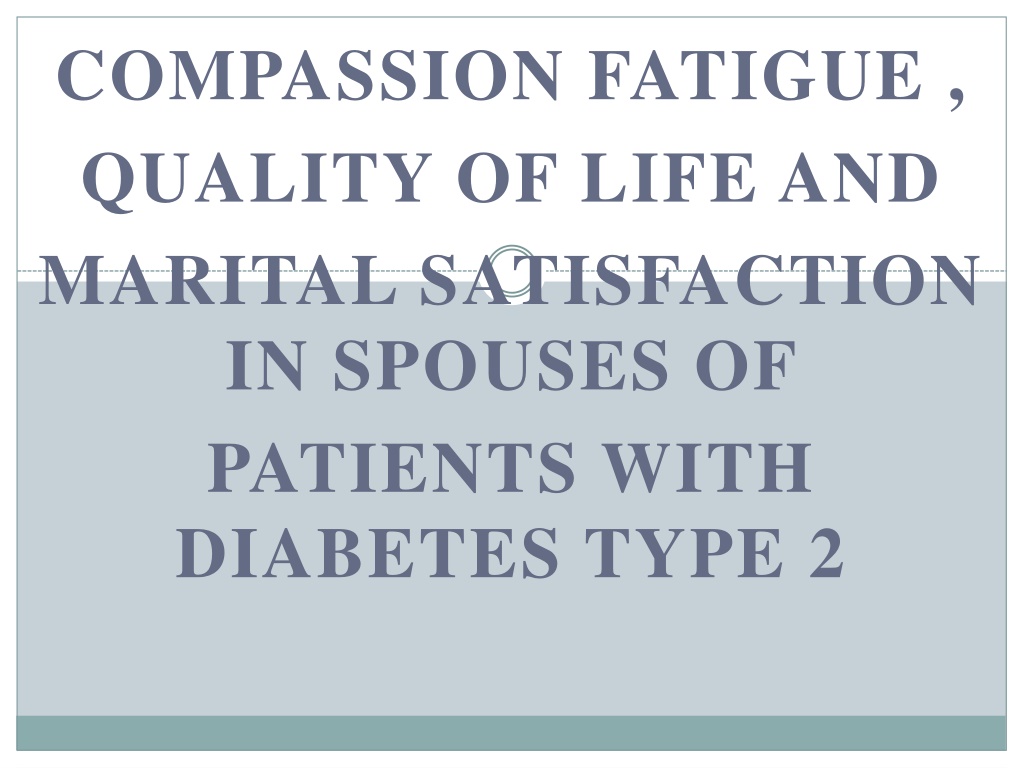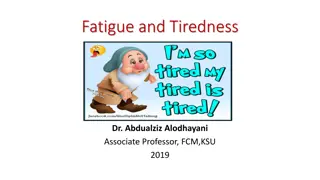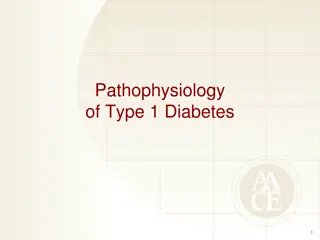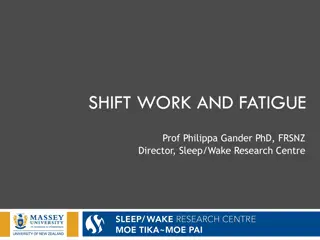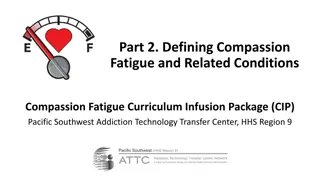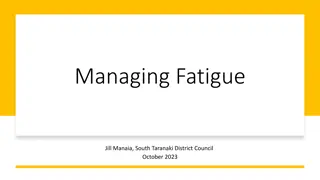Understanding Compassion Fatigue in Spouses of Type 2 Diabetes Patients
Compassion fatigue, a common phenomenon among spouses of individuals with type 2 diabetes, can impact quality of life and marital satisfaction. India faces a significant burden of diabetes, with a rising number of cases and high associated costs. The country also experiences an alarming trend of younger onset of diabetes, necessitating increased awareness and support for affected individuals. Addressing compassion fatigue and improving awareness are crucial steps in managing the diabetes epidemic in India.
Download Presentation

Please find below an Image/Link to download the presentation.
The content on the website is provided AS IS for your information and personal use only. It may not be sold, licensed, or shared on other websites without obtaining consent from the author. Download presentation by click this link. If you encounter any issues during the download, it is possible that the publisher has removed the file from their server.
E N D
Presentation Transcript
COMPASSION FATIGUE , QUALITY OF LIFE AND MARITAL SATISFACTION IN SPOUSES OF PATIENTS WITH DIABETES TYPE 2
DIABETES MELLITUS Diabetes is a problem with the body that causes blood glucose (sugar) levels to rise higher than normal. This is also called hyperglycemia. Type 2 diabetes is the most common form of diabetes. If one has type 2 diabetes the body does not use insulin properly. This is called insulin resistance.
India leads the world with largest number of diabetic subjects earning the dubious distinction of being termed the diabetes capital of the world
DIABETES FACTS It is estimated that 61.3 million people aged 20-79 years live with diabetes in India (2011 estimates). This number is expected to increase to 101.2 million by 2030. About 1 million people died from diabetes in India in 2012. 80% of people with diabetes live in low- and middle-income countries. The greatest number of people with diabetes are between 40 to 59 years of age.
A most disturbing trend is the shift in age of onset of diabetes to a younger age. Indians get diabetes on average 10 years earlier than their Western counterparts.
Lower proportion of the population is affected in states of Northern India (Chandigarh 0.12 million, Jharkhand 0.96 million) as compared to Maharashtra (9.2 million) and Tamil Nadu (4.8 million). (Indian Council of Medical research). Prevalence of diabetes in rural populations is one-quarter that of urban population. Costs of diabetes care are alarmingly high. The annual cost for India due to diabetes was about $38 billion in 2011. There is poor awareness about diabetes in the Indian population.
25% of an urban population are unaware of this medical condition. Only 12% are aware of the risk factors for diabetes. Even among people with diabetes, only 40% are aware of its effects.
COMPASSION FATIGUE Compassion Fatigue: Compassion fatigue is gradual reduction or lessening of compassion over a period of time. It is also known secondary traumatic stress(STS).
People such as nurses, psychologists etc who work directly with trauma victims mostly suffer from it. The symptoms of compassion fatigue are hopelessness, experiences of displeasure, anxiety etc. It affects individuals professionally and personally . According to recent studies approximately 85% of nurses working in emergency room meet the criteria for compassion fatigue (Hooper et al., 2010).
Many researchers have indicated that therapists who work with traumatized clients often show signs of psychological distress as a result of these interactions (Figley 1995; Nelson-Gardell and Harris, 2003). Stamm (1997 2005) found that compassion fatigue is more common among health care workers than among those in education or working with child and family issues. Researchers also have shown that compassion fatigue can take a toll on the care giver, causing decreased productivity, more sick days used (Vinayak, 2000;2011;2014).
Quality of Life According to the World Health Organisation (WHO, 1995) quality of life is the individual s perception of their position in life in the context of the culture and value systems in which they live and in relation to their goals, expectations, standards and concerns. It is a broad ranging concept affected in a complex way by the person's physical health, psychological state, level of independence, social relationships, personal beliefs and their relationship to salient features of their environment.
Investigators also have examined factors associated with the quality of life of spouses/partners of men with prostate cancer, who often report more emotional distress than their husbands (Kornblith et al., 1994).
Emotional distress in spouses is related to less education, greater uncertainty, worse marital quality, more negative interactions with the patient, and less positive meaning associated with the illness (Eton et al., 2005). Higher symptom distress in prostate cancer patients has been associated with poorer quality of life in their spouses (Kornblith et al., 1994).
Marital Satisfaction Mitchell & Boster (1998) explained marital satisfaction as the level of positive feelings felt by a married individual with regard to the couple s communication level, how well conflicts are resolved and how problems are navigated. Marital satisfaction exists on a continuum (from highly unsatisfied to highly satisfied) and is dependent upon the climate within the relationship.
Studies have revealed a positive relationship between spousal support and marital satisfaction within both healthy couples (Abbey, Andrews, & Halman, 1995; Kaur and Sharma, 2004;) and couples in distress (Abbey et al.,1995;Verma ,2011). A study by Baanders & Heijmans (2007) on the impact of care giving for a chronically ill partner, found that partners lives were adversely affected, including their personal lives, social relations, and financial well-being.
NEED OF STUDY Chronic illness affects not only the lives of those suffering from disease but also of those family members who care for them. Attending to the impacts of chronic illness on family members is important because the physical and emotional health of family caregivers has the potential to influence the health, welfare and successful rehabilitation of persons with the chronic illness (Verma,1999, Vinayak , 2011). Quality of life of care givers and the marital life of patients also play significant role in treatment of patients. Caring for a spouse with disease effect the life of care giving spouse in various ways and also influence their interpersonal relationships, including the one with their spouse.
There is a dearth of studies on compassion fatigue especially in spouses of patients with diabetes. The current study has been proposed to study compassion fatigue, quality of life and marital satisfaction in spouses of patients with diabetes 2.
OBJECTIVES To find out the inter-relationship of compassion fatigue, quality of life, and marital satisfaction among spouses of patients with diabetes type 2. To find out gender differences on compassion fatigue, quality of life and marital satisfaction in spouses of patients with diabetes type 2.
H YPOTHESES Compassion fatigue is negatively related to quality of life and marital satisfaction in spouses of patients with Diabetes 2. Female spouses are higher on compassion fatigue and lower on quality of life and marital satisfaction as compared to male spouses of patients with Diabetes 2.
METHODOLOGY Sample The sample for present study consisted of 120 spouses (60 males and 60 females) of patients with diabetes 2 , who were taking regular medicine for 3 to 4 years. The age range for the sample was 30 - 40 years. The sample was collected from tricity ( Chandigarh, Mohali, Panchkula).
INCLUSION CRITERIA Couples married for at least 5 years. Couples from middle income group . Couples where only male member was working . Couples with 1-2 children. Participants who were graduates.
EXCLUSION CRITERIA Patients/spouses undergoing treatment for any other chronic disease. Patients/spouses participating in any alternative healing practices. Patients/spouses undergoing any psychological treatment. Couples living separately.
SCALES Following standardised scales were used: Compassion fatigue (Figley, 1995). Marital satisfaction inventory (Fower and Olson,1993). Quality of life (Moudgil, Verma ,and Verma,1986). STATISTICAL ANALYSES: Inter correlations and t ratios were found.
Main Findings Significant negative relationships between compassion fatigue and quality of life, compassion fatigue and marital satisfaction in male as well as female spouses. Significant positive relationship was found between quality of life and marital satisfaction in both groups of spouses . Female spouses were found to be significantly higher on compassion fatigue and marital satisfaction and lower on quality of life as compared to male spouses.
IMPLICATIONS The study highlights the need to carry out psychological researches not only on patients of Diabetes but also on the spouses of the patients. There is a need to incorporate psychological intervention in the treatment schedule .
